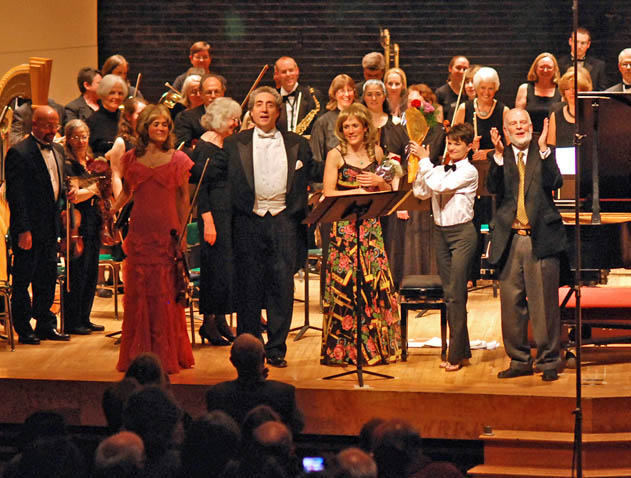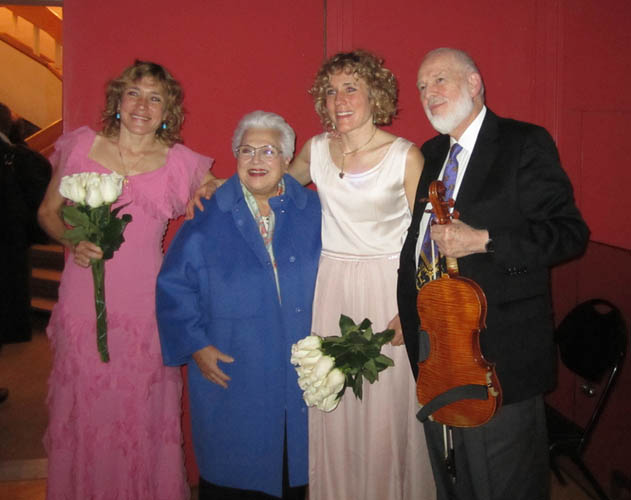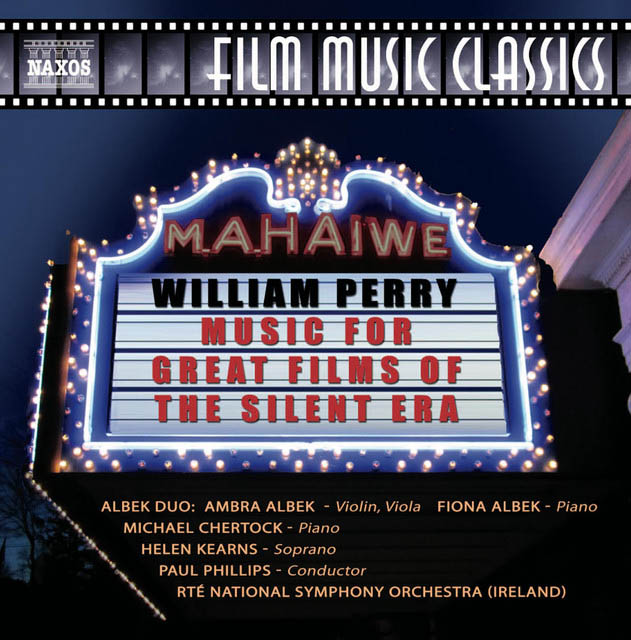Review: William Perry's Music for Great Films of the Silent Era - The Gemini Concerto
Although my review deals with recordings, it should not be forgotten that most of the compositions on this CD were also written with live performance in mind.
Home Page |
Newsletter, |
About live aspects of his works, William Perry explains that, "Since we live in an age that is largely visual compared to the radio days of my youth when one's imagination supplied the images to go with the audio experience, I have made a point of adding visual elements to my concert music whenever possible. It also helps to attract a younger audience."
Like film composer Erich Wolfgang Korngold before him, Perry wrote this unique concerto inspired by themes from seven of his own film scores. Featuring the Albek Duo, twin sisters Ambra on violin and viola and Fiona * on piano (thus the name Gemini), their performances are vibrant and hearty throughout the travel-themed set of six songs. Truly a musical fling around the world, the concerto possesses the rollicking thrills of a rollercoaster ride at its highest peaks, and the retrospective intimacy of a sail through a tunnel of love in more romantic moments. The six stops along the "world tour" effectively ignite the listener's imagination. As soon as one desires to sit down to perhaps reflect on the most recent musical "journey," we suddenly cannot resist the urge to climb aboard for the next leg of the grand world tour. It is a concerto that reveals itself anew with each listen, and can continue to be enjoyed and appreciated in your musical scrapbook of most treasured CDs.
[*William reflects, "This recording of The Gemini Concerto takes on historical importance because, sadly, pianist Fiona Albek succumbed to cancer in March of 2016. She was only 39."]

William Perry, far right: At the premiere of the Gemini Concerto on May 8, 2010, performed by the Albek Duo – violinist Ambra, far left, and pianist Fiona to the right of Paul Phillips, conducting the Pioneer Valley Symphony. Next to me is my wife, Marina, a ballerina from the Bolshoi Ballet in Moscow; she provided a visual element during the Concerto with signs and costumes introducing each of the cities and countries in the various movements.
Gemini Concerto: An Entertainment for Violin, Piano and Orchestra
Track 1: “Traffic go!” commands the opening Acme Thunderer whistle blast and the accompanying fanfare for Introduction and Travel Music. Jaunty orchestral swerving beckons the listener to jump aboard, and this irresistible overture to "anywhere" rushes along presto, making it easy to imagine yourself as one of the businessmen carrying briefcases and stepping clear of cars chomping at the bit, or running to catch the train just pulling into the station. All the while, the prominent, closely knit piano and violin duet plays on with hurry-flurry, traffic-jam discordance. Yet, somehow, the chaos retains orderliness in its "arrangement."
You feel assured that the policeman (or is it the orchestra conductor?), standing in the middle of the intersection waving his arms and directing the pizzicato and tremolo traffic with the stop-go whistle blow and triangle chimes, has everything under control. Perry's music will get you there, and the cymbal clash-bangs and orchestra fade-out announces that you have finally arrived at your destination. Keeping the theme, the introductory bars are incorporated with slightly different impressions depending upon "locale" at the beginning of the remaining tracks of the concerto.
Track 2: With its distinct Irish brogue in the piano and flute intro, the Dublin: Celtic Air and Runaway Reel sentimentally laments an Ireland one knew not so long ago. Its gently sentimental string solo, with a felicitous harp later gambolling within layers of string, wind and percussion, supports the early bars of the string solo.
The mimicking of bagpipes in the fast-paced Irish jig passage has a hand held out “join me” ambience, and soon the drum and kettle drum beats and tambourine whirl the strings and piano off toward the finish line. Laddies and lassies, the piano runs a pretty good race in this, but it's the violin that wins the sweepstakes. Perry shares about live performance of this movement, “Thus in the Dublin: Celtic Air and Runaway Reel movement of the Gemini Concerto, the violinist in one passage moves through the orchestra challenging the string sections to duplicate her fast bowing.”
Track 3: Berlin: Cabaret March and Berliner Lied in serious minor chords and its regal marching band oompahs, shifts mood when the band “turns the corner.” A more forte flute, horn and piano take the march down the street as the viola tremolos along. A prim martial snare beat sends the marching band back to the barracks, and then the melody mellows with European flair into a second half. Lighter-hearted piano chords accompanied by more romantic viola bow strokes scintillate in the spotlight, concluding with the dulcet viola diminishing before the last pinpoint note of a single piano key.
Track 4: After the lead-in on Moscow: Twilight Troika and Romance, early bars are richly saturated with an easily envisioned lustrous indigo starlight, suggesting a Russian midnight sleigh ride. The melody finds its glide with playful staccato bells of a troika of horses and the majestic, unshy weeping of a Slavic violin solo. (Indeed, the vivid, powerful violin voice in a number of specific bars could command my ancestors to get up and dance!) The song soon shines even brighter and softer, pleasantly, romantically, like a dreamed-of clandestine interlude in a private room reserved for Russian royalty in a secluded forest dacha. A Rachmaninoff-like arching piano solo, and the hopeful, sprite pizzicato in the middle of the violin solo and its soon tremolo, lead to a culminating crescendo of horns, low kettle drum heartbeats and an imperious cymbal clash, bow-tying the soulful embroidery of Russian themes.
Track 5: In the intro for the Vienna Polytonal Polka and Waltz: “Wiener Wein” (literally “Viennese Wine”), the melody implies that all who were invited have arrived. Then comes finding place and space as society position dictates after coats and hats are checked, with the orchestra sections cross-currenting chaotically in different scales, following the genteel class hither and thither in a grande ballroom perhaps.
About the composition itself, Perry elaborated in the CD liner notes: [The polka] “features polytonality, where the violin and piano play simultaneously in two different keys with the orchestra then adding a third .... The music is marked ‘Spritzig’ and the sound of corks popping and glasses tinkling is frequently heard.”
By mid-section, the song has reached the full stature and discipline of Johann Strauss. After those previous off-balance waltzes, the cork not only pops, but the bubbles flow into a more traditional waltz senso. The sparkling violin solo continues with pure fingering virtuosity. Perry relates that “...in the Wiener Wein waltz, the violinist walks into the audience rather like André Rieu - or indeed like Johann Strauss himself!”
Track 6: New York Broadway Ballet and Finale also has a bubble-pop reminiscent of a champagne cork, and a My Fair Lady quality. This melodic vista sweeps the dance circle of the whole stage/ballroom with a playful violin solo later including viola, in which the bows "dance" with delight on the strings. A snare drum and scale-climbing horns, and the fervent energy of the piano add to the orchestra's upbeat jazzy joy as the song heads toward a splendidly majestic finish.
Perry says about the performance highlights, “Near the end of the Broadway Ballet Finale, the violin and viola are twice exchanged in a matter of just seconds, a bit of extra visual excitement for the audience. The pianist stands to play the closing glissandi. [A rapid slide through a series of consecutive tones in a scale-like passage]. In one performance the orchestra had a dancer whirling on stage with signs announcing the cities.”

William Perry: At one of the Albek Duo 2010 recitals in New York City. Ambra Albek, the violinist is on the left, then the glorious Mezzo-soprano Marilyn Horne, pianist Fiona Albek and WP.
